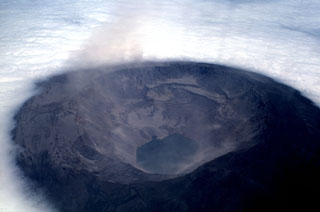Report on Fernandina (Ecuador) — 10 April-16 April 2024
Smithsonian Institution / US Geological Survey
Weekly Volcanic Activity Report, 10 April-16 April 2024
Managing Editor: Sally Sennert.
Please cite this report as:
Global Volcanism Program, 2024. Report on Fernandina (Ecuador) (Sennert, S, ed.). Weekly Volcanic Activity Report, 10 April-16 April 2024. Smithsonian Institution and US Geological Survey.
Fernandina
Ecuador
0.37°S, 91.55°W; summit elev. 1476 m
All times are local (unless otherwise noted)
Instituto Geofísico-Escuela Politécnica Nacional (IG-EPN) reported that the eruption at Fernandina continued during 10-16 April. Daily thermal anomalies were identified in satellite images, though during 12-14 April they were characterized as slight. Sulfur dioxide emissions based on satellite data fluctuating between about 120 and 658 tons per day. Gas-and-steam emissions rose from the area where lava entered the ocean based on satellite images; the emissions decreased on 13 April suggesting that only a very small amount of lava was entering the ocean. A new lobe of lava to the W of the main flow was identified in satellite images during 15-16 February.
Geological Summary. Fernandina, the most active of Galápagos volcanoes and the one closest to the Galápagos mantle plume, is a basaltic shield volcano with a deep 5 x 6.5 km summit caldera. The volcano displays the classic "overturned soup bowl" profile of Galápagos shield volcanoes. Its caldera is elongated in a NW-SE direction and formed during several episodes of collapse. Circumferential fissures surround the caldera and were instrumental in growth of the volcano. Reporting has been poor in this uninhabited western end of the archipelago, and even a 1981 eruption was not witnessed at the time. In 1968 the caldera floor dropped 350 m following a major explosive eruption. Subsequent eruptions, mostly from vents located on or near the caldera boundary faults, have produced lava flows inside the caldera as well as those in 1995 that reached the coast from a SW-flank vent. Collapse of a nearly 1 km3 section of the east caldera wall during an eruption in 1988 produced a debris-avalanche deposit that covered much of the caldera floor and absorbed the caldera lake.
Source: Instituto Geofísico-Escuela Politécnica Nacional (IG-EPN)

